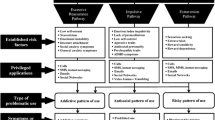Abstract
The gateway hypothesis proposes that use of cannabis directly increases the risk of consuming hard drugs. We test this controversial, but influential, hypothesis on a sample of cannabis users, exploiting a unique set of drug price data. A flexible approach is developed to identify the causal gateway effect using a bivariate survival model with shared frailty estimated using a latent class approach. The model suggests two distinct groups; a smaller group of “troubled youths” for whom there is a statistically significant gateway effect that more than doubles the hazard of starting to use hard drugs and a larger fraction of youths for whom previous cannabis use has less impact.
Similar content being viewed by others
References
Abbring JH, van den Berg G (2003) The non-parametric identification of treatment effects in duration models. Econometrica 71: 1491–1517
Ainslie G (1992) Picoeconomics. Cambridge University Press, Cambridge
Beenstock M, Rahav G (2002) Testing gateway theory: do cigarette prices affect illicit drug use. J Health Econ 21: 679–698
Bretteville-Jensen AL, Biørn E (2003) Heroin consumption, prices and addiction: evidence from self-reported panel data. Scand J Econ 105: 661–679
Bretteville-Jensen AL, Melberg HO, Jones AM (2008) Sequential patterns of drug use initiation—can we believe in the gateway theory? BE J Econ Anal Policy 8 (Contributions), Article 1
Deb P, Trivedi PK (1997) Demand for medical care by the elderly: a finite mixture approach. J Appl Econ 12: 313–336
DeSimone J (1998) Is Marijuana a gateway drug. East Econ J 24: 149–164
Fergusson DM, Horwood LJ (2000) Does Cannabis use encourage other forms of illicit drug use. Addiction 95: 505–520
Fergusson DM, Boden JM, Horwood LJ (2006) Cannabis use and other illicit drug use: testing the cannabis gateway hypothesis. Addiction 101: 556–569
Gaure S, Røed K, Zhang T (2007) Time and causality: a Monte Carlo assessment of the timing-of-events approach. J Econom 141: 1159–1195
Golub A, LaBouvie E, Johnson BD (2000) Response reliability and the study of adolescent substance use progression. J Drug Issues 30: 103–118
Heckman JJ, Honorè BE (1989) The identifiability of the competing risks model. Biometrica 76: 325–330
Heckman JJ, Navarro S (2007) Dynamic discrete choice and dynamic treatment effects. J Econom 136: 341–396
Horverak Ø (2006) Norwegian drinking pattern—undergoing change? In: Bryhni A (ed) Alcohol and drugs in Norway, Annual report, Norwegian Institute for Alcohol and Drug, Oslo, pp 28–39
Jenkins S (1995) Easy estimation methods for discrete-time duration models. Oxf Bull Econ Stat 57: 129–138
Kandel DB (1975) Stages in adolescent involvement in drug use. Science 190: 912–914
Lancaster T (1990) The econometric analysis of transition data. Cambridge University Press, Cambridge
Lyons MJ, Toomey R, Meyer JM, Green AI, Eisen SA, Goldberg J, True WR, Tsuang MT (1997) How do genes influence Marijuana use? The role of subjective effects. Addiction 92: 409–417
Ng SK, Krishnan T, McLachlan GJ (1995) The EM algorithm. In: Gentle JE, Härdle W, Mori Y(eds) Handbook of computational statistics.. Springer, Heidelberg, pp 137–168
Pacula RL (1998) Does increasing beer tax reduce Marijuana consumption. J Health Econ 17: 557–585
Pedersen W (2008) Hasjbruk blant unge (Young people’s cannabis use). Norwegian Med J 128(16): 1825–1828
Pudney S (2003) The road to ruin? Sequences of initiation to drug use and crime in Britain. Econ J 113: 182–198
van Ours JC (2003) Is Cannabis a stepping-stone for Cocaine. J Health Econ 22: 539–554
Williams J (2004) The effect of price and policy on Marijuana use: what can be learned from the Australian experience. Health Econ 13: 123–137
Yamaguchi K, Kandel DB (1984) Patterns of drug use from adolescence to young adulthood: III Predictors of progression. Am J Public Health 74: 673–681
Author information
Authors and Affiliations
Corresponding author
Rights and permissions
About this article
Cite this article
Melberg, H.O., Jones, A.M. & Bretteville-Jensen, A.L. Is cannabis a gateway to hard drugs?. Empir Econ 38, 583–603 (2010). https://doi.org/10.1007/s00181-009-0280-z
Received:
Accepted:
Published:
Issue Date:
DOI: https://doi.org/10.1007/s00181-009-0280-z




